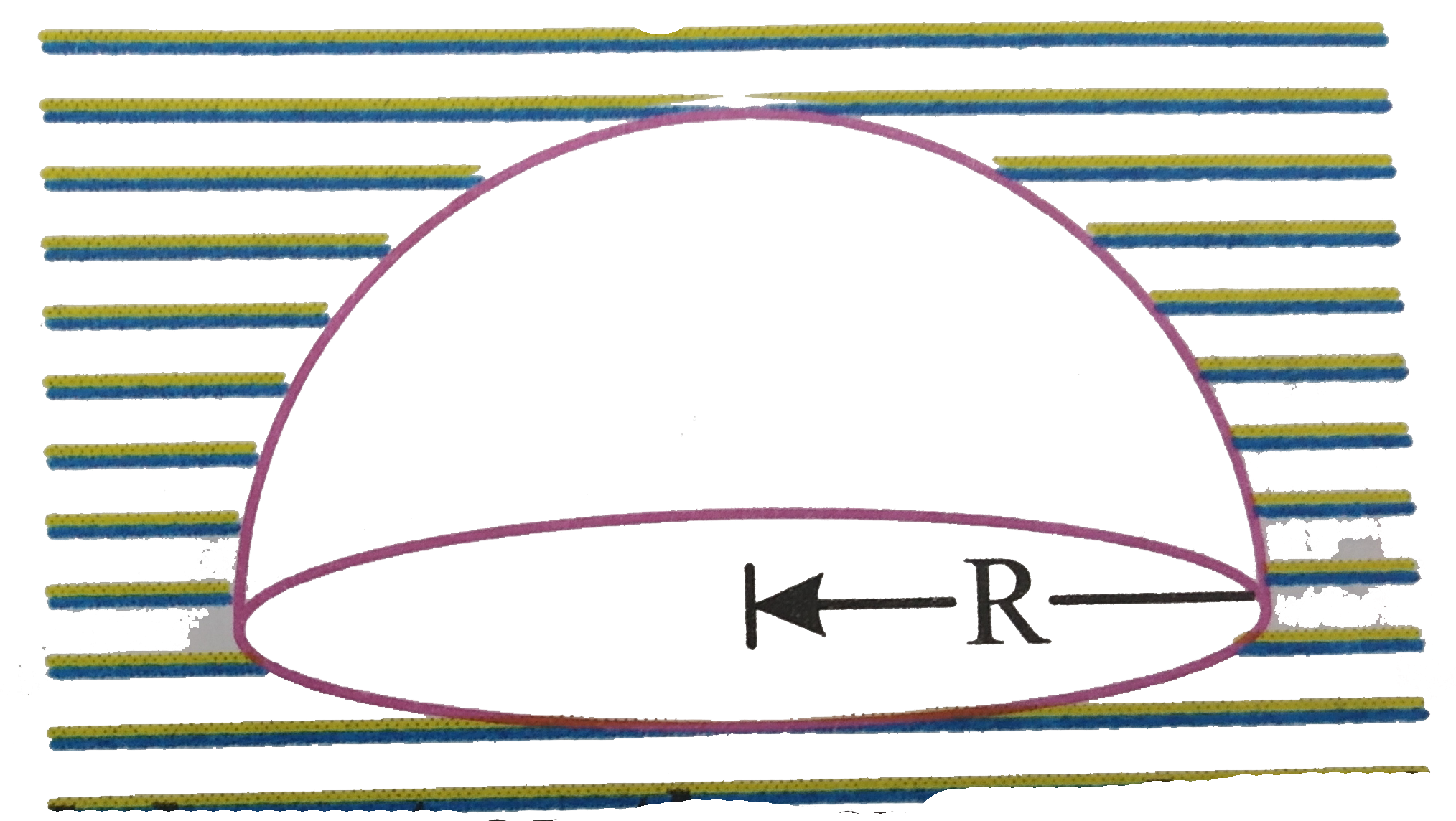There is a hemisphere of radius R having a uniform volume charge density ρ. Find the electric potential and field at the centre
The correct Answer is:E=ρR4∈0;V=ρR24∈0
To solve the problem of finding the electric potential and electric field at the center of a hemisphere with radius R and uniform volume charge density ρ, we can follow these steps:
Step 1: Calculate the Total Charge
The total charge Q contained in the hemisphere can be calculated using the volume charge density ρ and the volume of the hemisphere.
The volume V of a hemisphere is given by:
V=23πR3
Thus, the total charge Q is:
Q=ρ⋅V=ρ⋅23πR3
Step 2: Calculate the Electric Potential at the Center
The electric potential V at a point due to a charge Q at a distance r is given by:
V=Q4πϵ0r
For a hemisphere, we consider the potential at the center, where r=0. However, we can use the formula for the potential due to a continuous charge distribution. The potential at the center of the hemisphere can be expressed as:
V=Q4πϵ0R
Substituting for Q:
V=ρ⋅23πR34πϵ0R=ρR26ϵ0
Step 3: Calculate the Electric Field at the Center
The electric field E at the center of the hemisphere can be derived from the total charge. The electric field due to a uniformly charged hemisphere at its center is given by:
E=Q2πϵ0R2
Substituting for Q:
E=ρ⋅23πR32πϵ0R2=ρR3ϵ0
Final Results
Thus, the electric potential V at the center of the hemisphere is:
V=ρR26ϵ0
And the electric field E at the center of the hemisphere is:
E=ρR3ϵ0
The total charge Q contained in the hemisphere can be calculated using the volume charge density ρ and the volume of the hemisphere.
V=23πR3
Thus, the total charge Q is:
Q=ρ⋅V=ρ⋅23πR3
The electric potential V at a point due to a charge Q at a distance r is given by:
V=Q4πϵ0r
For a hemisphere, we consider the potential at the center, where r=0. However, we can use the formula for the potential due to a continuous charge distribution. The potential at the center of the hemisphere can be expressed as:
V=Q4πϵ0R
Substituting for Q:
V=ρ⋅23πR34πϵ0R=ρR26ϵ0
The electric field E at the center of the hemisphere can be derived from the total charge. The electric field due to a uniformly charged hemisphere at its center is given by:
E=Q2πϵ0R2
Substituting for Q:
E=ρ⋅23πR32πϵ0R2=ρR3ϵ0
Thus, the electric potential V at the center of the hemisphere is:
V=ρR26ϵ0
And the electric field E at the center of the hemisphere is:
E=ρR3ϵ0
Topper's Solved these Questions
- ELECTROSTATICSBook:ARIHANTChapter:ELECTROSTATICSExercise:Level 3
Explore 59 Videos
- ELECTROSTATICSBook:ARIHANTChapter:ELECTROSTATICSExercise:Level 3
Explore 59 Videos
- ELECTROMAGNETIC INDUCTIONBook:ARIHANTChapter:ELECTROMAGNETIC INDUCTIONExercise:Level 3
Explore 12 Videos
- GEOMETRICAL OPTICSBook:ARIHANTChapter:GEOMETRICAL OPTICSExercise:Level 3
Explore 9 Videos
Similar Questions
A sphere of radius 2R has a uniform charge density p. The difference in the electric potential at r = R and r = 0 from the centre is:
View SolutionA uniform disc of radius R is charged with a uniform surface charge density σ. Find the electric potential due to the charges on the disc at a point on its edge. [σRπ∈0]
View Solution
Knowledge Check
Figure shows a uniformly charged hemisphere of radius R. It has a volume charge density ρ. If the electric field at a point 2R, above the its center is E, then what is the electric field at the point 2R below its center?
 AρR/6ε0+EBρR/12ε0−EC−ρR/6ε0+EDρR/12ε0+E
AρR/6ε0+EBρR/12ε0−EC−ρR/6ε0+EDρR/12ε0+E
An infinity long cylinder of radius R has an infinitely long cylindrical cavity of radius R2 are shown in the figure. The remaining portion has uniform volume charge density ρ. The magnitude of electrical field at the centre of the cavity is-AρR6ε0BρR4ε0CρR2ε0DρR3ε0An insulated sphere of radius R has a uniform volume charge density λ. The electric field at a point A, which is at distance r from its center is given by (R>r)
AZeroBRλ/3∈0C2rλ3∈0Drλ3∈0
A quarter ring of radius R is having uniform charge density λ. Find the electric field and potential at the centre of the ring.
View SolutionA smooth chute is made in a dielectric sphere of radius R and uniform volume charge density. ρ. A charge particle of mass m and charge -q is placed at the centre of the sphere. Find the time period of motion of the particle?

View SolutionA non-conducting sphere of radius R has a spherical cavity of radius R/2 as shown. The solid part of the sphere has a uniform volume charge density ρ. Find the magnitude and direction of electric field at point (a) O and (b) A.

View Solution
A solid hemisphere of radius R is made to just sink in a liquid of density ρ find the
View SolutionAn insulated sphere of radius r haas a uniform volume charge density λ. The electric field at a point A, which is at distance r from its centre is given by (R>r)
View Solution

